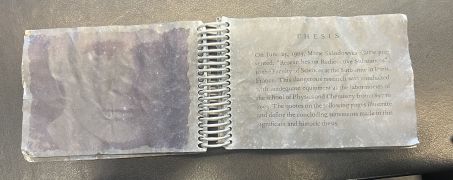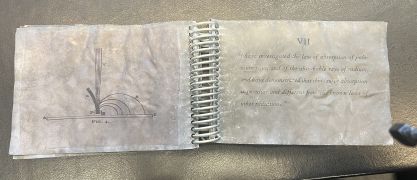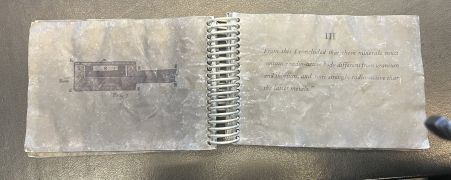Susan Kae Grant - Radioactive Substances: Difference between revisions
| Line 87: | Line 87: | ||
=== Contextual Significance === | === Contextual Significance === | ||
<gallery mode=" | <gallery mode="packed"> | ||
Image:IMG_8913.jpeg|thumb|Scroll titled "LABORATORY" | Image:IMG_8913.jpeg|thumb|Scroll titled "LABORATORY" | ||
Image:IMG_8914.jpeg|thumb|Scroll titled "THESIS RESEARCH" | Image:IMG_8914.jpeg|thumb|Scroll titled "THESIS RESEARCH" | ||
Revision as of 17:06, 12 May 2024
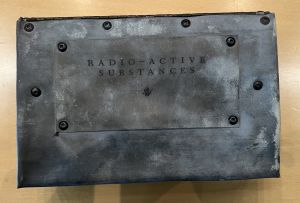
Introduction
Created in 1994-1995 for the exhibition "Science and the artist's book" held at the Smithsonian Institution and the Washington Project for the Arts in 1995, Susan Kae Grant's Radio-active Substances is like no other artists' book I've ever seen before. Housed at theUniversity of Pennsylvania's Kislak Center for Special Collections, Rare Books and Manuscripts, the book appears to be something you would find in a chemistry laboratory as opposed to a library. Encased in a small lead box are 5 glass tubes and a 10 x 15 cm spiral note book consisting of 28 pages and various illustrations that all honor the legacy of Maria Sklodowska Curie. Renowned as the first scientist to win the Nobel Prize twice, in 1903 and 1911, Curie accomplished more than what most women could even dream of at the time. Described as Grant's "evocative interpretation of Curie's 1903 dissertation presented at the Sorbonne in Paris" [1], Radio-active Substances portrays Curie's biggest life challenge: the struggle to balance her duties as a wife and mother with her unwavering pursuit of scientific knowledge in an era that disproved of the latter. In addition, the book illustrates the physical and emotional burden that accompanied Curie's radioactive endeavors.
Metadata
Date / Time Period
- Not physically written in the book
- The artists' book was produced in 1994-1995 for the exhibition "Science and the artist's book"
Place
- Not physically written in the book
- The artist's book was created at the Visual Studies Workshop in Rochester, New York.
Publisher
- Not physically written in the book
- The artists' book was created and self-published by Susan kae Grant in Dallas, Texas.
Copyright / Licensing
- All of Grant’s work are copyrighted as her intellectual property. The copyright is dated 1995.
Provenance
- The book was acquired directly from the artist by Penn, it is number 10 out of 20 total limited-edition copies.
- Acquired for the Penn Libraries with assistance from the Edgar Fahs Smith Memorial Fund.
Historical Context
Artists' Books
Defined by Art historian Stephen Bury as "books or book-like objects over the final appearance of which an artist has had a high degree of control; where the book is intended as a work of art in itself", artists' books challenge the current idea of what constitutes a book. Although artists' books with the traditional codex format can certainly be found, the genre's increased popularity stems from the flexibility and variation that exists between works. Utilizing both their artistic capabilities and authorial expertise, artists have created non-traditional books out of a wide range of substrates, techniques, forms, and mediums for years; a prime example of this phenomenon is William Blake's Songs of Innocence and of Experience, an early precedent for emphasizes the book as an artistic production.
These works would set the tone for later artists' books, connecting self-publishing and self-distribution with the integration of text, image and form. All of these factors have remained key concepts in artists' books up to the present day.
exemplify certain featur es which later find vari ed expression in artists' books,
This unique art helps tell the story of each poem, and was part of Blake's original vision for how each poem should be understood old maxim“a picture is worth a thousand words”rings false
As Bury notes, women artists were often shut outof the gallery system and so turned to the medium of the book to take control ofthe presentation and distribution of their work
The increased popularity of artists' books can probably be.attributed to the flexibility and variation of the book form, rather than to any single-aesthetic or material factor.
Hecites the silence of Max Ernst’s collage novels as inspiration for works where images rather than texts provide the narrative.
Marie Curie
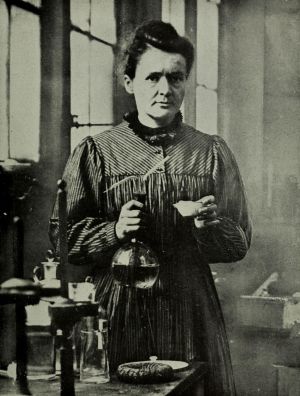
Maria Salomea Skłodowska, commonly known as Marie Curie, was born in Warsaw on November 7th, 1867 as the fifth and youngest child of well-known educators Bronisława and Władysław Skłodowski. Born during a time of political unrest, specifically due to national uprisings aimed at restoring Poland's independence, Curie's childhood was marred with poverty and illness. After losing both her mother and older sister in a short span of time, Curie fell into depression and moved to the countryside with her paternal relatives. While in the countryside, Curie offered tutoring services to many students until she saved enough money to fund her higher education. In 1891, Curie moved from Poland to France and enrolled in the University of Paris where she continued her studies in physics, chemistry, and mathematics. After earning two degrees by 1894, Curie chose to remain in Paris and begun her scientific career with an investigation of the magnetic properties of various steels. A few months later, Curie met Pierre Curie, an instructor at The City of Paris Industrial Physics and Chemistry Higher Educational Institution and her soon to be future husband. In summer of 1895, the two got married and began their long journey of scientific exploration. After countless years of arduous labor and publications, the couple were finally able to announce the newfound existence of two elements, polonium and radium; they were also the first to coin the term "radioactivity". Unfortunately, unaware of the deleterious effects associate with radiation exposure, in 1934, Curie succumbed to aplastic anemia at the age of 66 due to her long-term, unprotected investigation of radioactive substances; she left behind two daughters and a long lasting legacy as the first woman to win a Nobel Prize, the first person to win a Nobel Prize twice, and the only person to win a Nobel Prize in two scientific fields.
Material Analysis
Radioactive Substances consists of three individual objects that together form the entirety of Grant's artist book: a small box, a 10 cm x 15 cm spiral notebook, and a set of 5 glass test tubes.
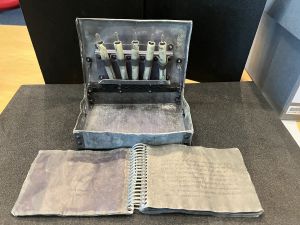
Substrate
Box: The book and test tubes are both protected in a mauve stained box measuring 5 in x 6 in x 2 in. Upon first glance the box appears to have been poorly handled in the past, featuring many indentations, rough edges, and a sunken lid. However, once picked up, the reader is surprised to find out that the box is actually constructed of a soft metal material, specifically lead. Despite its rigid appearance, the box is malleable and its shape can be manipulated, contributing to its imperfection. In addition, although a majority of the box is constructed out of lead, steel nails, banding clips, wires, and hinges are used to provide support and uphold the box's rectangular shape. Once opened, a lead rack bolted to the lid of the box can be found. The rack features a ledge and a bended strip of metal used to create a resting place for the 5 glass test tubes. The inside is otherwise left empty with just enough space to house the accompanying notebook.
Notebook: The notebook encased in the box consists of 14 one-pound sheets made entirely of lead. Apart from its 15 pound weight, which comes as a surprise to many readers due to its small size, another interesting feature of the notebook is the flexibility of the pages. Although also constructed out of lead, similar to the box, the individual sheets that make up the notebook are so thin that they bend as the pages are turned. To help make the reading experience a bit easier, the spiral binding that holds all the pages together is made out of solid steel, allowing the reader to flip through the artists' book without the spine collapsing under the weight of the page. Once opened, the notebook features juxtaposing images and text. The images, collected from a variety of historical sources depict sketches, blueprints, and writing from Curie's personal journal, as well as images of the female scientist and her husband. The images are printed in black ink directly unto the grey lead pages and differ greatly in terms of ambiguity, contrast, and lighting. The text is also directly printed onto the lead pages in a legible font. Apart from the Thesis on the first page and the colophon on the last pages, the text featured are quotes taken directly from Curie's 1903 thesis titled "Researches on Radioactive Substances"
Test Tubes: The artists' book also consists of 5 glass lead-lined test tubes that each contain a vellum scroll of text. The test tubes are synonymous to the one typically found in a laboratory and each house a clear, glass rod. Once removed, the glass rods are revealed to be dowels attached to long strips grey vellum paper. Each scroll features a different title and text sourced from a biography written Curie's daughter; all five scrolls aim to articulate Curie's personal life journey as a wife, mother, and researcher. Although the scrolls are not super fragile, if mishandled, they can tear. Thus, two hands are necessary to properly analyze this part of the artists' book. Interestingly, once placed in the dark, the lead that lines the inside of the test tubes begins to glow, imparting an aura to the artists' book that is simultaneously fascinating and dangerous.
-
Image of test tubes with lights on
-
Image of glowing test tubes with lights off
Form and Structure
-
Title page + juxtaposing portrait of Marie Curie
-
Thesis page + juxtaposing zoomed in image of Marie Curie
-
Page 1 + Juxtaposing image of Curie in the lab
-
Page 3 + juxtaposing image of Curie's original figure
-
Page 7 + juxtaposing image of Curie's original figure
-
Page 9 + Juxtaposing image Curie with her husband
The binding style of Radio-active Substances diverges from the format of conventional books intended solely for reading. Typically, such books utilize a technique called Perfect binding, a book binding method widely used in the mass production of paperback and hard cover books. This binding technique involves gluing the multitude of pages that comprise a book together at the spine with a strong yet flexible thermal glue. The stack of pages is then trimmed to produce "perfect edges" and attached to a cover. In contrast, Grant's artists' book adopts spiral binding to secure the lead pages together, a technique typically used to make books designed for writing rather than straightforward reading. Such books include notebooks, planners, and sketchbooks. Despite this departure from the norm for reading-oriented books, Radio-active Substances' form and structure is contemporary with the time and place in which which it was published.
Significance
Physical Significance
The physical significance of Grant's book lies in its replication of an object that most likely could've been found in Curie's lab over a hundred years ago. According to curators at the Pierre and Marie Curie collection at France's Bibliotheque National, all of Curie's scientific papers are housed in lead-lined boxes and it is mandatory to wear protective clothing when consulting them. Even after many years, much of Maris Curie's belongings - her furniture, her cookbooks, her research equipment, and her manuscripts - are still radioactive and considered too dangerous to handle. In addition, in his 2008 book "The Vertigo Years: Europe, 1900-1914" historian Philipp Blom quotes Marie Curie's autobiographical notes in which she describes carrying test tubes containing radioactive isotopes of polonium and radium in her pocket and storing them in her desk drawer, remarking on the faint blue-green glow the tubes gave off in the dark. However, the luminescent tubes, which Curie referred to as "faint, fairy lights", were equally as dangerous as they were beautiful, electrifying the air with traces of radioactivity. Essentially, by mimicking the physicality of an potentially dangerous object that could have been found in the Curie's lab during the height of their research endeavors, Radio-active Substances "resonates with an aura of scientific discovery while also telegraphing danger, fear, decay and toxicity".[1]
Contextual Significance
-
Scroll titled "LABORATORY"
-
Scroll titled "THESIS RESEARCH"
-
Scroll titled "WIFE & STUDENT"
-
Scroll titled "WIFE, MOTHER & STUDENT"
-
Scroll titled "PHYSIOLOGICAL EFFECTS"
Although both the book and test tubes are housed within the same lead box, the two parts of the artists' book emphasize two very different aspects of Curie's life. The easily accessible notebook is filled with meticulous descriptions of her experimental procedures, her scientific discoveries, her laboratory apparatus and an array of other insightful content that underscores Curie's role as a scientist. When flipping through the pages, it seems as if the reader is reading one of the many laboratory notebooks that Curie kept as primary records of her research. The same however cannot be said for the vellum scrolls inside the test tubes. Arguably harder to read in comparison to the notebook due to their fragility and inability to lay flat, the scrolls highlight the lesser known side of Curie - her life as a student, wife and mother. The excepts featured on the scrolls detail Curie's struggles with pregnancy, marriage, motherhood, health, housekeeping and many other facets of her personal life. Yet, much like the test tubes, this part of Curie's identity often remains obscured, overshadowed by her legacy as a scientist. Only upon further examination does her identity as a woman faintly illuminate in the dark.
Symbolic Significance
As JoAnna Drucker writes in The Century of Artists' Books:
“ [W]hen a book calls attention to the conceits and conventions by which it normally effaces its identity, then it performs a theoretical operation... A book can call attention to the external factors which determine its structure or the book can become an object whose structural features are its subject matter"
When considering Grant's Radio-active Substances, the main structural feature that emerges as the book's subject matter is its substrate. With its symbolism as an isolator of radiation, it seems ironic that an artists' book designed to honor the legacy of Marie Curie would be constructed out of the very substrate that could have potentially saved her life. However, by integrating the materiality of the book into her artistic expression, Grant demonstrates self-reflectivity, or the action of highlighting the medium's capacity for artistic expression beyond mere storytelling or dissemination of information.[2] Her unconventional use of substrate in this case allows the reader to engage in a tactile experience that is both fascinating and heartbreaking. As one interacts with the artist's book, they inevitably ponder on the tragic exposure to radiation that defined Curie's scientific contributions. The malleability, weight, texture, and other physical characteristics of the book, draw the reader into a deep reflection of Curie's complex legacy, marred with personal sacrifice and intolerable pain. Ultimately, Grant's deliberate choice of a lead substrate not only enriches the tactile experience of the artists' book but also emphasizes the emotional narrative woven within its pages; a narrative that explores the intersection between art, science, and the human experience.
References
- ↑ 1.0 1.1 BA Radio-Active Substances — Susan kae Grant.” n.d. Susan kae Grant. Accessed May 4, 2024. https://www.susankaegrant.com/radio_active-book-arts.
- ↑ 2.0 2.1 Drucker, Johanna. The Century of Artists’ Books. Granary Books, 2004.



